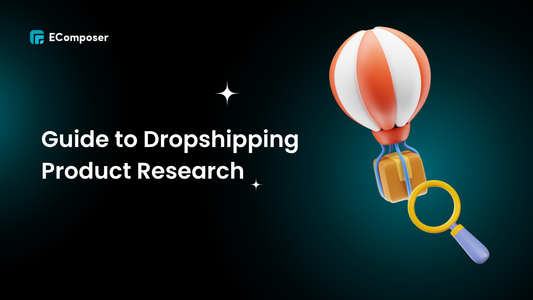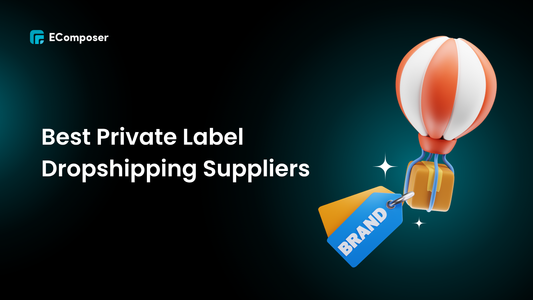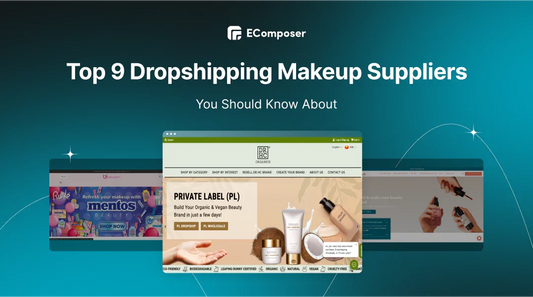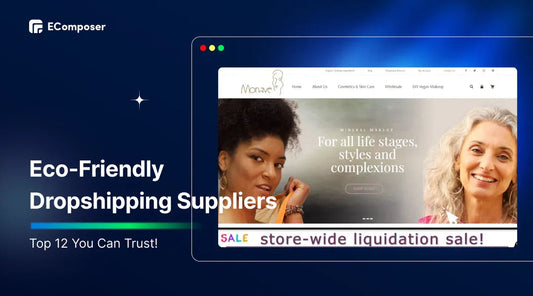Dropshipping 101: Full Guide To Success for Beginners

Table Of Contents
Dropshipping is a popular and simple way to start making money online. It lets you sell products from other suppliers through your own online store without managing inventory or shipping. Instead, it allows you to focus on branding and promoting your business since your supplier handles these tasks.
While it might sound like an easy setup, dropshipping is still a business, and success takes effort. It requires solid market research, smart marketing, and dependable supplier relationships. With online shopping on the rise, there’s room for new businesses to step in.
This guide will provide you a full guide on dropshipping for beginners in 10 key steps. Let’s begin by looking at what dropshipping really is and if it’s the right fit for you.
What is Dropshipping? Is it still profitable?
Dropshipping is an online retail model where sellers offer products without keeping inventory themselves. When a customer buys an item, the seller forwards the order details to third-party suppliers, they then ship it directly to the buyer. The approach is really a popular choice for new online business owners since it allows sellers to avoid inventory costs and risks.
How Dropshipping Works: Product Selection > Order Placement > Shipping by Supplier

(Image Source: jnt.asia)
- Product Selection: Retailers pick products to showcase in their online store.
- Order Placement: When a customer places an order, the retailer sends the details of it to the supplier.
- Shipping by Supplier: The supplier packages and ships the product straight to the customer.
Is Dropshipping Profitable?
Dropshipping still looks promising, with strong growth predicted for the coming years. The global market for dropshipping is expected to reach $476.1 billion by 2026, growing at a yearly rate of 28.8% CAGR.

(Image Source: Oberlo)
This growth can be attributed to many key factors:
- Low Barrier to Entry: Entrepreneurs can start with minimal investment since there’s no need for inventory.
- Reliance on Suppliers: Business success depends on reliable suppliers for quality and timely shipping.
- Shifting Consumer Preferences: Dropshippers need to follow trends and innovate to stay relevant.
- Diverse Product Offerings: Retailers can easily test and expand their product range without financial risk.
Overall, these trends indicate that dropshipping will continue to be a solid and potentially profitable business model in 2024 and beyond, especially for those who handle market challenges well and use smart marketing strategies.
Is Dropshipping Right For You?

If you're looking to start a business with low upfront costs and minimal risks, then dropshipping can be an excellent option. Here are some signs that dropshipping might be the right choice for you:
- You Want to Start Small: If you're hesitant to put in a lot of money upfront, dropshipping allows you to sell products without needing to buy inventory first. You only pay for items after a customer orders them.
- You Prefer Flexibility: With dropshipping, you can easily change or add products to your online store. This flexibility lets you test different items and see what your customers like best.
- You Want to Focus on Marketing: If you're more interested in marketing and building a brand than managing inventory and shipping, dropshipping can be a great fit. You can concentrate on promoting your business while suppliers handle the logistics.
- You’re Ready to Learn: Dropshipping might be easier than traditional retail, but it still requires research and effort. If market trends, customer preferences, and effective marketing strategies are things you can handle, then dropshipping can be a rewarding venture.
If these points attract you, then it might be a great path to consider exploring a dropshipping business.
Steps to Start a Dropshipping Business for Beginners
Step 1: Research Dropshipping Market
When done correctly, market analysis offers valuable insights about current trends, what consumers are thinking, and how the competition is performing. This information makes it much easier for beginners to start dropshipping.

(Image Source: grandviewsearch.com)
Here are some reliable ways to conduct research:
- Identify Trends: Use tools like Google Trends, Semrush, and Ahrefs to spot trends, gather information about what consumers are interested in, and see how popular certain products are.
- Browse Marketplaces: Check out platforms like Amazon, eBay, and Etsy to find out what’s trending and what appeals to customers around the world.
- Analyze Competition: Look for and study successful dropshipping stores. Examine their product offerings, customer reviews, pricing, and marketing strategies.
Just by gaining a solid understanding of the market, you can discover what’s missing and fill that gap with unique dropshipping products.
Step 2: Pick a Niche with Products to Sell

(Image Source: EComposer’s Template)
After your research, the next step is to pick a niche that helps you stand out from competitors.
What is a niche? It’s a specific product that appeals strongly to a particular group of people. For example, think about t-shirts for cat lovers or aprons for dads who love grilling. An identified niche makes it easier to sell, faces less competition, and can lead to higher profits.
A niche is a segment of the market that you can target with your store, brand, and product selection. Just selecting a dropshipping niche, you can better identify your target audience, making it simpler to search for products to sell.
When choosing a niche, start with something you’re passionate about. There’s no right or wrong way to pick a niche; your success depends on how well you navigate the challenges of that industry.
Here are some tips for choosing a niche:
Choosing a broad niche can feel overwhelming and stressful. For instance, if you decide to target women's clothing, you’ll have to consider thousands of products, which can stretch you too thin. It might be better to focus on one category first like blouses for now and add more later.
On the flip side, you can sell just one product and still be financially successful. A one-product website is easier to manage than a store with many products.
Learn more on Top Dropshipping Business Ideas That Bring Big Profits in our blog.
Step 3: Team Up with Reliable Dropshipping Suppliers

Working with reliable suppliers is essential for your dropshipping success. They manage your inventory, process orders, and ship products directly to your customers. Choosing the right supplier impacts both your profits and customer satisfaction.
A good supplier ensures consistent product quality and timely deliveries. Using dropship supplier tools can help you find reliable suppliers. Some of the best options include:
- Spocket
- Printful
- Salehoo
- Printify
- Dropified
- HyperSKU
- AppScenic
- Syncee
Once you’ve found a reliable supplier, it’s important to test them regularly. Place an order from your own store to test product quality and shipping times and see if the product quality matches your expectations.
Setting the right prices is also vital for maintaining profitability. When deciding on prices, consider supplier costs, shipping fees, and competitor pricing. Balancing these factors will help you set competitive prices that attract customers while ensuring your business can grow.
Using dropship supplier tools can help you find reliable suppliers. These directories often integrate with Shopify and some with WooCommerce. Each tool has its own advantages which we will discuss further in the later section.
Step 4: Choose the Right eCommerce Platform
When you're setting up your dropshipping store, picking the right e-commerce platform is very important.
Your best options for building a store are:
- Shopify
- WooCommerce
Popular platforms like Shopify and WooCommerce have different features based on how easy they are to use, how much they can grow with your business, and how well they work with dropshipping tools.

Shopify is great for beginners because it's easy to navigate. It is more simple to source products and fulfill orders since Shopify connects with many dropshipping apps. Shopify also takes good care of hosting, security, and updates, so you don't have to worry about those details.
Already in love with Shopify? Take advantage of Shopify's $1 deal and explore any plan from A to Z in your first month!
Grab $1 Deal Now!

WooCommerce is a plugin of WordPress, it is suitable for those who want to have more control over how their store looks and functions because it provides a lot of customization options. However, you'll be responsible for things like security and hosting, which means you’ll need some technical knowledge.
As you consider your options, keep these points in mind:
- Pick a platform that works well with payment systems and offers good design features.
- Use apps like DSers, Spocket, and Printful to automate tasks and connect with suppliers.
- Consider using AI tools to create effective product descriptions and enhance your photos.
- Look into options like Shopify Collective, which allows you to partner with brands in the U.S. and sell each other’s products.
Some of the other marketplaces like Etsy, Amazon, or even social media like Facebook and Instagram can also be considered to sell your products on. Selling on multiple channels is usually a good idea because it can help your business get more visibility and increase sales. Just make sure you have the time and resources to manage all these different selling channels effectively.
Step 5: Create Your eCommerce Dropshipping Store

(Image Source: EComposer’s Template)
After choosing your sales channel, set up a store that represents your brand, showcases your products, and encourages sales. The process for setting up your storefront may differ based on the channel, but here are some key things to keep in mind:
- Provide detailed information: Build trust by sharing as much relevant information as possible. Some of them can be an "About Us," "Contact Us," and "Frequently Asked Questions" page so customers can see that your business is legitimate.
- Use high-quality images: Show off your products with clear and attractive images that accurately represent what customers will receive.
- Set Up Payment Options: Choose payment methods that your customers can use to buy from your store. Most platforms will allow you to accept credit cards, PayPal, and other options, making it easy for customers to pay.
- Design Your Store: Make sure your store looks good and represents your brand well. Use templates or themes to create a professional appearance. Focus on a clean layout that makes it easy for customers to find what they’re looking for.
💡 Pro tip: Try EComposer to create a beautiful Dropshipping store and share the touching story of your business. Include cute photos and behind-the-scenes moments to engage your audience and help them connect with you
Try it FREE!While setting up a storefront isn't too hard, you can hire an expert to save you time and effort.
Step 6: Establish an Easy Order Fulfillment Process

Once you've got your products, store, and marketing strategy in place, the next step is to set up a smooth order fulfillment process. This is how your customers' orders will be processed, packed, and shipped.
Here's how to make it simple:
- Connect with Your Supplier: Make sure your supplier can quickly process orders. Good communication is key. If a customer places an order, you should be able to send the order details to your supplier without delay.
- Automate Where Possible: Use tools and apps to automate parts of the order fulfillment process. This can help reduce errors and save you time. Look for dropshipping apps that can link your store to your supplier, so orders are processed automatically.
- Track your orders: Keep an eye closely on your orders to ensure they're being processed and shipped on time. You can use your dropshipping software to track the status of your orders.
- Set Clear Shipping Policies: Clearly communicate shipping times and costs on your store. Let customers know the duration when they can expect their orders and any potential delays. This transparency helps manage customer expectations.
- Handle Returns Smoothly: Have a plan for returns and exchanges. Make sure your customers know how to return items and what your policy is. A straightforward return process can improve customer satisfaction and encourage repeat business.
Doing all of these steps, you can establish a seamless order fulfillment process that will help you grow your dropshipping business.
Step 7: Register Your Business

Another important step is to handle the legal aspects of your dropshipping store. It means checking if you need a business license to dropship where you live. Be sure to research the rules for your specific country.
If you’re in the United States, you’ll need a sales tax ID and an employer identification number for tax purposes and to apply for wholesale dropshipping accounts.
After you understand the regulations, think about setting up a legal business entity to protect yourself from potential legal issues. This can also help you partner with better suppliers and businesses.
Here are the three most common business types:
- Sole Proprietorship: With this setup, your business income is taxed as your personal income. However, this option is risky because your business and personal assets are legally connected.
- Limited Liability Company (LLC): This creates a separate legal entity for your business, giving you protection for your personal assets. You will have different legal obligations when it comes to paying taxes as a business owner.
- Corporation: Like an LLC, a corporation is a separate legal entity. However, corporations are owned by shareholders and managed by directors rather than just a few owners.
In addition to registering your business, create these important policy pages to make your online store appear more professional:
- Refund Policy: Show that your dropshipping business is a safe place to shop.
- Return or Exchange Policy: Reassure customers that they can return or exchange items if they don’t meet their needs.
- Terms and Conditions: List out the rights and responsibilities of your business and customers, helping to manage expectations and protect your business.
- Privacy Policy: Demonstrates that your business takes customer information seriously.
Step 8: Plan a Pricing Strategy

Setting the right prices for your products is key to making your dropshipping business profitable. Your pricing strategy should cover all costs and ensure you still make a profit. Here’s a simple approach:
- Cover Product and Shipping Costs: You can calculate how much you’ll pay your supplier for each product, plus any shipping fees. The total is your base cost, and your price must be higher than this to make a profit.
- Add a Markup for Profit: A markup is an amount you add to cover your expenses (like website fees, marketing, and software) and earn some profit. Many dropshippers use a percentage markup, such as 30-50%, depending on the competition and demand for the product.
- Research Competitor Pricing: Check how much similar products are selling for on other online stores. If you’re priced too high, customers might choose a competitor, and if you’re too low, it could hurt your profits. Aim for a competitive price that still brings in profits.
- Consider Offering Discounts: You might decide to offer discounts during holidays or sales events to attract more customers. Factor in these promotions when planning your pricing to ensure you’re still making a profit even with a discount.
- Review and Adjust Prices Over Time: Market trends, demand, and costs can change, so be flexible with your pricing. Regularly review your prices and adjust if needed to stay profitable and competitive.
With a well-thought-out pricing strategy, you can ensure that your dropshipping store is profitable while still attracting customers.
Step 9: Promote Your Dropshipping Business

The final step in launching your dropshipping business is promoting it to attract customers. Here’s how to get started:
- Identify Your Audience: Define who your ideal customers are by looking at their age, interests, and shopping habits. When you know your audience, it will help you create messages that connect with them.
- Pick Your Channels: Choose marketing channels where your customers spend the most time, like social media, email, or blog content to reach them effectively.
- Create Engaging Content: Share eye-catching images of your products, customer reviews, and behind-the-scenes glimpses of your business to build interest and trust.
- Use SEO: Optimize your product descriptions and website with keywords that match what customers search for. Tailor your SEO based on whether you’re selling on your own site or a marketplace.
- Run Promotions: Offer discounts or bundles to attract new customers and urge them to make their first purchase.
- Analyze & Adjust: Track your marketing results with tools like Google Analytics to see which strategies work best. Then, refine your approach based on what drives the most sales.
- Engage with Customers: Respond actively to comments and messages on social media to build a community. Gathering feedback is essential for improving your products and marketing strategy.
Promoting your business is about testing and learning. Stay open to trying new approaches and adjusting based on what gets the best results.
Step 10: Improve Your Dropshipping Business

After you’ve launched your dropshipping store, it’s time to focus on improvements to keep your business growing. You can start with sharing your store link with friends, family, and social media followers to get initial traffic. Those first sales are exciting, but remember, this is just the beginning.
Focus on enhancing your store and customer experience by gathering feedback. Ask customers to leave reviews and pay close attention to comments about product quality, delivery times, and customer service—these insights are invaluable for making changes that will encourage repeat business.
Regularly analyze your revenue and traffic data to see which products are popular and which marketing efforts are bringing in the most visitors. Use this information to modify your product selection and promotions. Consider adding new items, keeping your store updated with seasonal products, and staying aware of trends in your niche to keep your offerings fresh.
Building a successful dropshipping business might take time and commitment, so stay patient and be open to learning along the way. With continuous effort and a focus on improvement, your business can steadily grow.
Other Related Posts:
21 Best Free Dropshipping Suppliers in USA, No Membership Fees
Top 15 Dropshipping Suppliers Florida For All Businesses
Which Shopify Plan is Best for Dropshipping?
How to Choose the Right Dropshipping Suppliers
One of the main difficulties in dropshipping is finding reliable suppliers. Many suppliers seem dependable at first but may not prioritize your business as you’d expect.
Here’s what to look for in a good supplier:
- Product Quality – Choose a supplier who keeps quality standards. Whether the standard is high or low, products should meet expectations consistently.
- Shipping Standards – Look for suppliers with fast and affordable shipping options.
- Warehouse Location – Ideally, find a supplier with a warehouse near your target market to reduce both shipping time and costs.
- Technology and Efficiency – The best suppliers have systems you can easily integrate with your store. You can find these suppliers on dropship platforms like Spocket and AppScenic.
- Return Policies – Avoid suppliers who don’t accept returns. Reliable suppliers take responsibility and handle mistakes well.
For more tips, learn more our detailed guide on choosing the right dropshipping supplier.
Pro tips to Start Dropshipping

Starting a dropshipping business could be exciting, but a few smart moves can create all the difference in setting up for success. Here are some simple, effective tips to help you stand out from the competition and keep customers happy.
- Fulfill Orders Smartly: Try to process orders efficiently, making sure items reach customers as fast as possible. Building a reliable system for order fulfillment can help avoid delays and keep customers happy.
- Adopt Simple Shipping Rules: Keep shipping options simple to avoid confusing customers. Clear, easy-to-understand shipping policies can make the checkout process smoother.
- Handle Chargebacks Quickly: If customers ask for refunds or dispute charges, address these issues promptly. Resolving chargebacks quickly can help keep your business in good standing with payment providers.
- Manage Your Inventory Levels: Stay on top of your inventory to avoid selling items that aren’t in stock. Tracking inventory levels can help prevent delays and ensure customers receive their orders on time.
- Provide Great Customer Support: Good customer service can set you apart from competitors. Quickly answer questions, help customers with issues, and make sure they have a positive shopping experience.
- Consider Branded Dropshipping: Once your business grows, think about branded dropshipping—adding your logo or packaging to products. It makes your store feel more unique and trustworthy.
These tips can help you provide a smooth, reliable shopping experience for customers, setting your dropshipping business up for success in the long run.
Closing Thoughts
Every successful business starts with a simple idea, no matter how small. Starting a dropshipping business from scratch is an exciting way to explore the market, gain experience in running your own business, and build something that matters.
With the steps in this guide, you’re on the path to making your dropshipping store a reality. So, here’s the big question: Are you ready to start your dropshipping business from home and watch your idea grow into a successful venture?
FAQs about Dropshipping
- Is $100 to $500 enough to start dropshipping?
Yes, a budget of $100 to $500 can be enough to kick-start a dropshipping business. This amount should cover basics like your domain name, website hosting, and some initial marketing efforts. But keep in mind that growing a dropshipping business may require ongoing investments in advertising, managing stock, and scaling as you expand.
- How do I start learning dropshipping?
To start learning dropshipping, you can:
- Take online courses or watch tutorials on sites like Udemy, Coursera, or YouTube.
- Read books and follow blogs from experienced dropshippers.
- Join forums and social media communities to connect with other dropshippers.
- Start with a few products and put more effort on building a strong foundation.
- Try different products, marketing techniques, and pricing to see what works best.
- Is dropshipping worth it for beginners?
Yes, dropshipping can be a good business choice for beginners, especially if you’re interested in e-commerce and marketing. It does require dedication, patience, and a willingness to learn. Starting small, focusing on a niche, and continuously improving your approach can help you build a successful dropshipping business.
- What are the best dropshipping products for beginners?
When selecting products for your dropshipping store, you should consider:
- Niche: Target a specific group of customers with unique products.
- Profit Margin: Pick items with higher profit margins to increase your earnings.
- Shipping Time: Go for items with faster shipping to keep customers happy.
- Trends: Stay updated on popular and trending items.
Some good product categories for beginners are:
- Tech gadgets
- Home decor
- Fashion accessories
- Health and wellness items
- Pet supplies





















0 comments